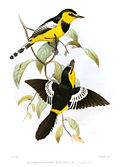| Black butcherbird | |
|---|---|
 | |
| Scientific classification | |
| Kingdom: | Animalia |
| Phylum: | Chordata |
| Class: | Aves |
| Order: | Passeriformes |
| Family: | Artamidae |
| Subfamily: | Cracticinae |
| Genus: | Melloria Mathews, 1912 |
| Species: | M. quoyi |
| Binomial name | |
| Melloria quoyi | |
| Synonyms | |
Cracticus quoyi | |
The black butcherbird (Melloria quoyi) is a species of butcherbird in the family Artamidae. It is found in Australia, Indonesia, and Papua New Guinea. Its natural habitats are subtropical or tropical dry forest, subtropical or tropical moist lowland forest, and subtropical or tropical mangrove forest.









